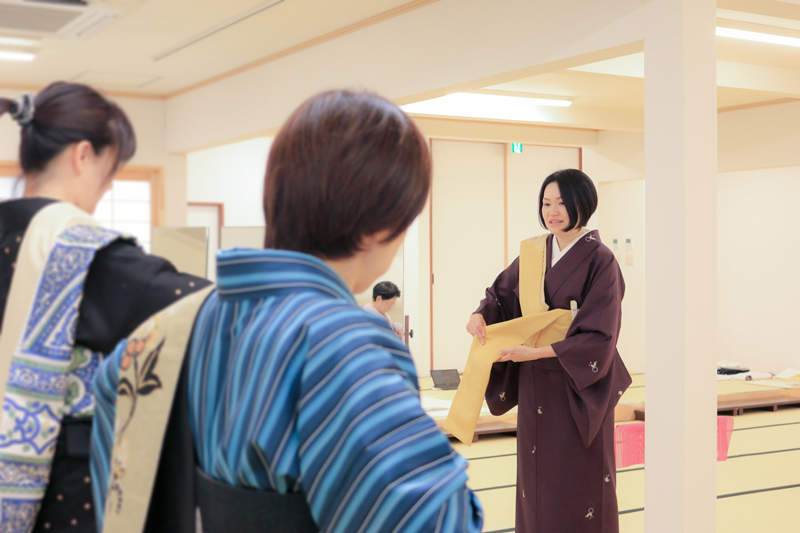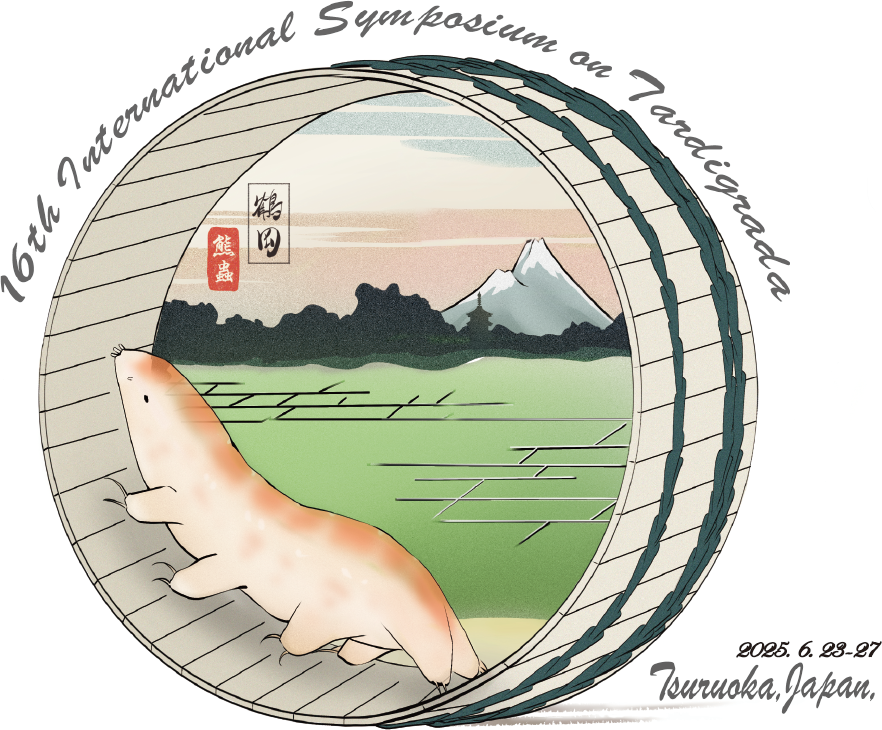Program
In this section you will find all about the Symposium Program – from an overview, through a detailed program.
Schedule overview
-
The symposium spans five days, with four keynote talks and oral and poster presentations. Details on the submission would be announced by Dec. 2024.
There would be many social events, including symposium banquet and half-day excursion. Details on the registration types would also be announced later in the year.
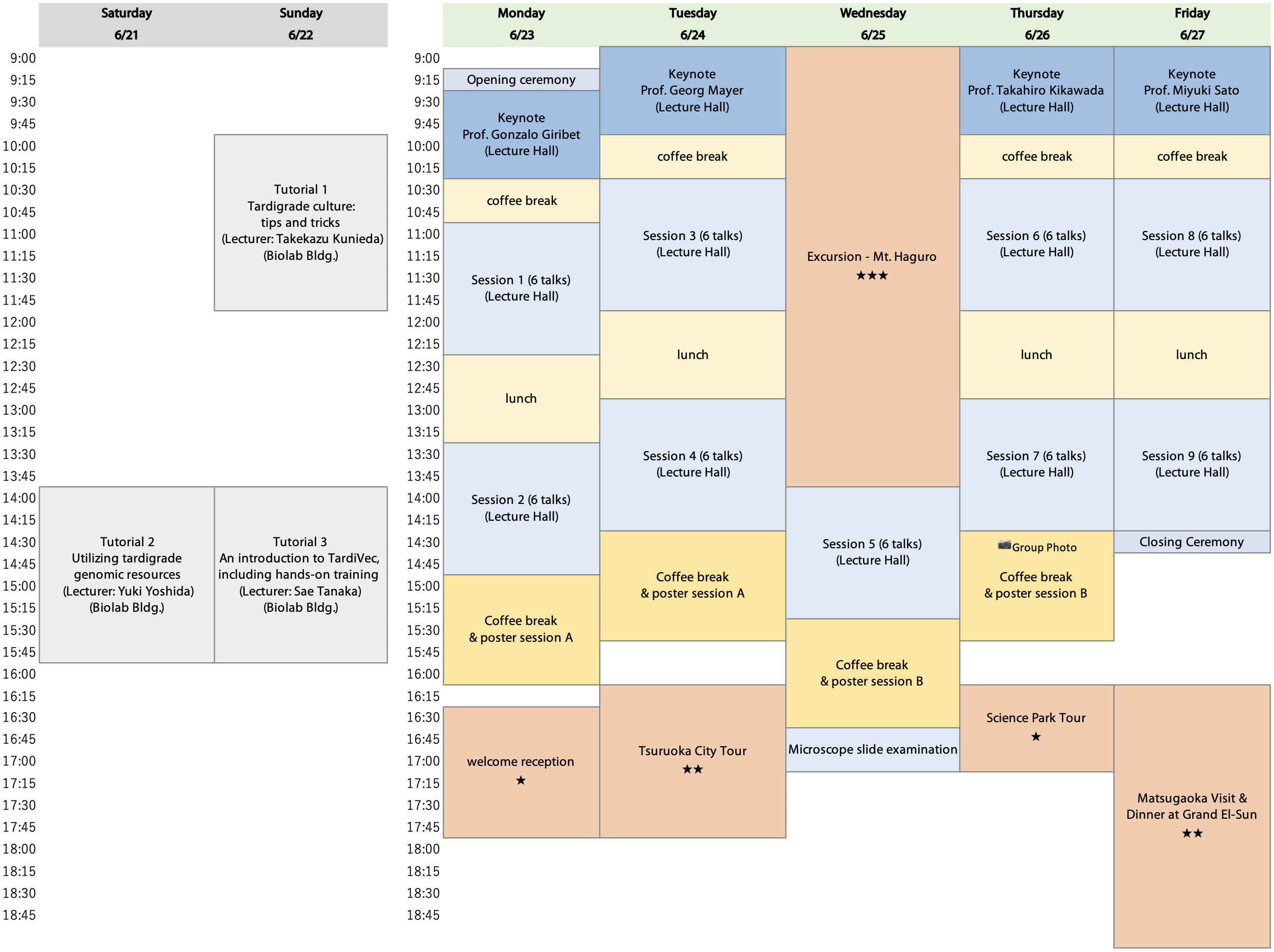
Program details
-
Below is the detailed program.
[* – Young Scientist Award Contestants]
Keynotes:
6/23 Mon.
An overview of ecdysozoan phylogeny: Where do we stand?
Gonzalo Giribet (Museum of Comparative Zoology, Harvard University, USA)
6/24 Tue.
Advances in the study of onychophorans and tardigrades – learning about arthropod evolution from their closest relatives
Georg Mayer (Department of Zoology, Institute of Biology, University of Kassel, Germany)
6/26 Thu.
Toward dry preservation of cells: what we learn from anhydrobiosis in tardigrades and the sleeping chironomid
Takahiro Kikawada (Institution, Countrynstitute of Agrobiological Sciences, NARO, Tsukuba, Japan)
6/27 Fri.
Physiological functions of lysosomal degradation pathways during the oocyte-to-embryo transition: lessons from C. elegans
Miyuki Sato (Institute for Molecular and Cellular Regulation, Gunma University, Japan)
Session 1 (6/23 Mon. morning):
- Phylogenetic identification and classification of the genus Macrobiotus (Eutardigrada: Macrobiotidae) in the Trans-Mexican Volcanic Belt
Daniel López-Sandoval, Tila M. Pérez - A big tree of a tiny bear: first extensive multilocus phylogeny of the genus Minibiotus (Eutardigrada: Macrobiotidae)
Aleksandra Sumlińska *, Alejandro López-López & Łukasz Michalczyk - ‘Everything is Everywhere’ or ‘Everything is Complicated’? Global patterns of tardigrade species distributions unveiled by HTS.
Łukasz Michalczyk, Witold Morek, Piotr Gąsiorek, Pritam K. Dey, Justyna Pogwizd, Aleksandra Sumlińska, Andrzej Ostoja-Wilamowski, Olga Kozioł, Napat Emdee, Payal Dash, Karol Wałach, Magdalena Dudziak & Alejandro López-López - A new species of Diaforobiotus (Eutardigrada: Richtersiusidae) from Mount Tlaloc (Mexico)
Roxana Abigail Flores-Romero *, Bernardo Daniel López-Sandoval, Joel Vincenzi, Michele Cesari, Roberto Guidetti, Enrico Ruiz, Alba Rocio Dueñas-Cedillo & Francisco Armendáriz-Toledano - Spiny bears: A new species of Ramazzottius (Eutardigrada: Ramazzottiidae) from Mexico, with updated single and multi-locus phylogenies for the genus
Jorge Romero-Mendoza *, Sara Brandoli, Joel Vincenzi, Michele Cesari, Roberto Guidetti, David Hérnandez-Mena, Rosario Mata, Gerardo Rivas - A new Indo-Australian hypsibioidean lineage evokes a discussion on the higher systematics of the superfamily Hypsibioidea (Eutardigrada: Parachela)
Pritam K. Dey, Piotr Gąsiorek, Alejandro López-López & Łukasz Michalczyk
Session 2 (6/23 Mon. afternoon):
- Post-Gondwanan ore, or where does Oreella (Heterotardigrada) stand?
Piotr Gąsiorek, Witold Morek, Łukasz Michalczyk - Seamount tardigrades from the research cruise KM20-10C (JAMSTEC), North-western Pacific Ocean
Shinta Fujimoto, Natsumi Hookabe, Naoto Jimi, Tomo Kitahashi, Yoshihiro Fujiwara - The curious case of the high school biology teacher who lost his water bear and the (eventual) reinstatement of Batillipes caudatus
Paul Bartels, Paulo Fontoura, Diane Nelson, Łukasz Kaczmarek - Tardigrade diversity and community composition in freshwater lakes from Yunnan (Southwest China)
Yujuan Wang *, Ganmin Lin, Shicheng Wang, Xiaoya Ma - A Comprehensive Online Key to Tardigrade Genera
Gary Grothman - “Tardigrades go to school!” The Citizen Science project to study the Italian biodiversity
Tiziana Altiero, Ilaria Giovannini, Gianluigi Prato, Sara Brandoli, Roberto Guidetti, Lorena Rebecchi
Session 3 (6/24 Tue. morning):
- Environmental DNA (eDNA) for studying tardigrade biodiversity: lights and shadows
Payal Dash, Łukasz Michalczyk, Alejandro López-López - Catch tardigrade environmental DNA, if you can: first review of existing primer pairs and the design of new ones
Federica Frigieri *, Elia Lo Parrino, Michele Cesari, Benedetta Barzaghi, Letizia Saviola, Ilaria Giovannini, Gentile Francesco Ficetola, Lorena Rebecchi, Roberto Guidetti - An optimised molecular-based method for ecological study of tardigrades in soils
Zi-Yang He, Hang-Wei Hu, Keren Wu, Li Bi, Shuo Na, Anthony Weatherley, Michael Nash, Ji-Zheng He - DNA metabarcoding reveals the effects of altitude and substrate on tardigrade diversity
Yelyzaveta Matsko *, Bartłomiej Surmacz, Yevgen Kiosya, Izabela Poprawa, Daniel Stec - Investigating tardigrade communities across elevational and urbanisation zones with environmental DNA (eDNA)
Payal Dash *, Łukasz Michalczyk, Alejandro López-López - Application of the Subfossil Tardigrada Remains to the analysis of storm and tsunami deposits – preliminary results.
Weronika Erdmann, Łukasz Kaczmarek, Witold Szczuciński
Session 4 (6/24 Tue. afternoon):
- Scientific correspondence related to the controversy over resuscitation of animalcules and spontaneous generation
Atsushi C. Suzuki - Tardigrades and ants: revealing an unknown phoresy
Ilaria Giovannini, Daniele Giannetti, Edoardo Massa, Enrico Schifani, Lorena Rebecchi, Roberto Guidetti, Donato A. Grasso - Not as picky as thought: new records and insights into the natural history of Propyxidium tardigradum (Ciliophora: Operculariidae)
Karol Wałach *, Nadia Książkiewicz, Jane Thomas, Brian Blagden, Łukasz Michalczyk - Live Slow, Survive Long: The Secrets of Tardigrades Life
Wiktoria Dmuchowska *, Michalina Krakowiak, Jędrzej Warguła, Robert Nawrot, Łukasz Kaczmarek - Marine Tardigrade Research at University of Vigo: Advances in Culture and Magnetic Field Sensitivity
Cintia Cabada, Marcos Rubal, Ana Ulla-Miguel, Daniel Rey, Milagrosa Aldana - What’s new in tardigrade research in Poznań – present and future
Łukasz Kaczmarek, Magdalena Bartylak, Tomasz Bartylak, Wiktoria Dmuchowska, Weronika Erdmann, Andonis Karachitos, Hanna Kmita, Michalina Krakowiak, Robert Nawrot, Anastasiia Polishchuk, Piotr Rzymski & Jędrzej Warguła
Session 5 (6/25 Wed. afternoon):
- Building a Systems Neuroscience Toolkit in Hypsibius exemplaris
Ana Lyons *, Sae Tanaka, Yu-Tung Yeh, Kazuharu Arakawa, Saul Kato - Pigment-dispersing factor neuropeptides act as multifunctional hormones and modulators in tardigrades
Soumi Dutta, Lars Hering, Milena M. Grollmann, Niklas Metzendorf, Vladimir Gross, Kazuharu Arakawa, Susanne Neupert, Monika Stengl, Friedrich W. Herberg & Georg Mayer - Examination of the effects of different mitochondrial respiratory chain inhibitors on tardigrades
Tomasz Bartylak *, Michalina Krakowiak, Edyta Fiałkowska, Hanna Kmita, Łukasz Kaczmarek - How does ibuprofen affect the ovaries of tardigrade Paramacrobiotus experimentalis?
Aleksandra Miernik, Filip Wieczorkiewicz, Sebastian Student, Edyta Fiałkowska, Izabela Poprawa - The effect of ibuprofen on the midgut ultrastructure of the tardigrade Hypsibius exemplaris (Eutardigrada, Parachela)
Filip Wieczorkiewicz *, Alper Arslan, Sebastian Student, Izabela Poprawa - Examination of effects of bisphenol A on tardigrades
Magdalena Bartylak *, Michalina Krakowiak, Jędrzej Warguła, Edyta Fiałkowska, Piotr Rzymski, Robert Nawrot, Łukasz Kaczmarek
Session 6 (6/26 Thu. morning):
- Tardigrade Resistance to Mixed Gamma–Neutron Radiation
Jitka Nováková, Domnik Vítek, Tadeáš Fryčák, Jakub Pavlík, Barbora Machová, Patricie Neumanová, Filip Fejt, Jiří Voller - Multi-omics landscape and molecular basis of radiation tolerance in a tardigrade
Lingqiang Zhang, Dong Yang, Lizhi Wang, Guangyi Fan, Lei Li, Zhengping Ge, Shihao Liu, Kun Zheng, Yaqi Li, Kaiqi Chen, Yesheng Fu - Tardigrades Survive and Respond to an Extreme Range of Environmental pH
Paige Shukwit *, Molly Jane Kirk, Joel H. Rothman - Tardigrade Resistance: Insights from SALT Experiments
Sanil Raveendranathanpillai, Elssa Ann Koshy, Jaini Shukla, Wafikul Khan, Jaya Krishna Meka, Ragav Ramachandran, Thirukumaran V, Anil Bhardwaj, Vijayan S, Bhalamurugan Sivaraman - Molecular evolutionary insights in tardigrades: linking genomic signatures to radiotolerance and developmental specialization
Dong Yang, Chaoran Li, Shihao Liu, Yaqi Li, Kun Zheng, Lei Li, Lingqiang Zhang
Session 7 (6/26 Thu. afternoon):
- Cryptobiosis sub-states revisited
Nadja Møbjerg, Aslak Jørgensen - Effect of habitat, volume of surrounding water and body size on supercooling capacity of tardigrades and rotifers
Anna Veselá *, Vladimír Šustr, Jan Rozsypal, Miloslav Devetter, Karel Janko, Michala Tůmová - Transcriptomic response to desiccation in an underexplored tardigrade clade
Joel Vincenzi *, Anne De Cian, Quentin Helleu, Ilaria Giovannini, Roberto Guidetti, Jean-Paul Concordet, Lorena Rebecchi & Michele Cesari - It’s a small world after all: single-cell insights into the biology of tardigrades
Kazuharu Arakawa, Sae Tanaka - Spatial transcriptomics uncovered subtypes of storage cells and a large gene family conserved in Tardigrada
Sae Tanaka, Kazuharu Arakawa - Investigating the Tardigrada Lipid Landscape
Pavel Barahtjan *, Nika Goršek, Jean Maillat & Giovanni D’Angelo
Session 8 (6/27 Fri. morning):
- Chromatin Binding Dynamics of the Tardigrade-Unique DNA-Protecting Protein Dsup in the Nucleus of Living Cells
Kota Shinzaki *, Takekazu Kunieda - ROS levels in animals and released storage cells of Paramacrobiotus experimentalis is shaped differently by age, sex, and anhydrobiosis duration
Amit Kumar Nagwani *, Łukasz Kaczmarek, Thomas C. Boothby & Hanna Kmita - Mitochondrial Genomes: An Unexploited Powerhouse for Tardigrade Evolutionary Studies
Sara Brandoli *, Leandro Gammuto, Quentin Helleu, Edoardo Massa, Lorena Rebecchi, Valentina Serra, Giulio Petroni & Roberto Guidetti - Identification of the causal gene in an albino tardigrade mutant by genome resequencing and CRISPR-mediated gene editing
Takekazu Kunieda, Tokiko Saigo, Koyuki Kondo - Exploration of tardigrade genomes: heterozygosity patterns and symbionts
Witold Morek *, Lewis Stevens, Łukasz Michalczyk, Mark Blaxter - Comprehensive analysis of the DNA mutation landscape in Ramazzottius varieornatus
Yuki Yoshida, Kazuharu Arakawa
Session 9 (6/27 Fri. afternoon):
- Oogenesis of Milnesium inceptum (Tardigrada, Apochela)
Izabela Poprawa, Yelyzaveta Matsko, Anna Urbisz, Filip Wieczorkiewicz, Anna Krakowska, Edyta Fiałkowska, Karol Małota - A “tail” as old as time: a short story
Marc A. Mapalo *, Frank W. Smith, Javier Ortega-Hernández - Preliminary research using FE-SEM technique to explore internal structures of tardigrades
Ji-Hoon Kihm, Pilmo Kang, Tae-Yoon S. Park - Comparative analysis of tardigrade locomotion, and the role of GABA in interleg coordination
Sierra Houck, Bella Potakey, Ryan Markin, Gili Butler-Furlong, Woods Vargas, Emily Penny, Te-Wen Lo, Ian Woods - Impact of Surface Features on Tardigrade Traction Forces
Atharva Agashe, Lucas Ying Ho Yeh, Brage Gunderson, Bahareh Behkam, Kazuharu Arakawa, Amrinder Nain - Cellular morphology and serial homology of leg muscles in Hypsibius exemplaris
Vladimir Gross, Georg Mayer
Accompanying persons
-
Tours are planned for the afternoon of Monday, Tuesday, Thursday, Friday for accompanying persons, providing unique opportunities for Tsuruoka’s culture, attractions, and seasonal delights. Lunch, and other social activities are coordinated to be with other delegates.
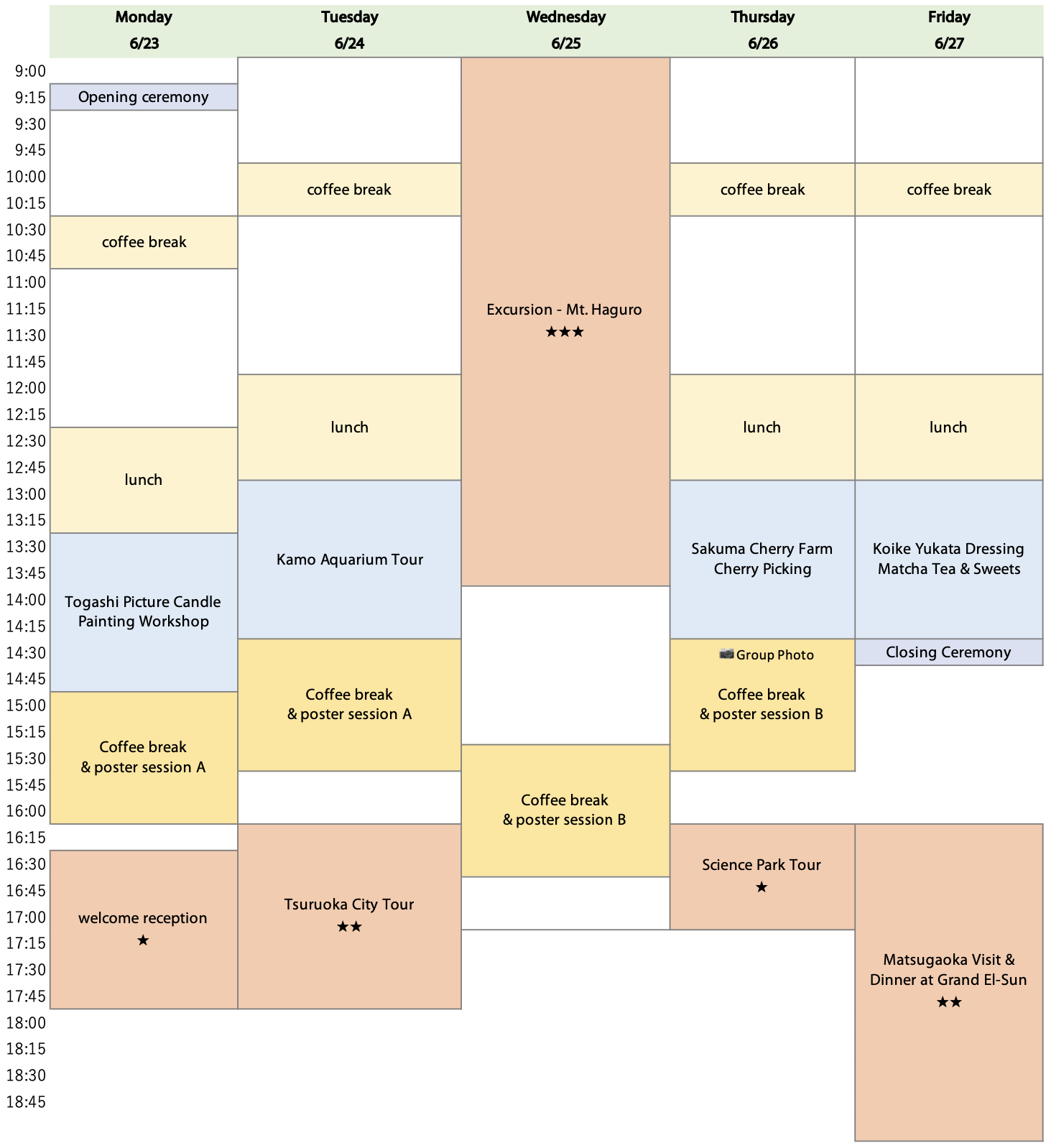
Monday – Togashi Picture Candle Painting Workshop
The venerable painted candles once presented to the Tokugawa shogunate during the feudal lords’ alternate-attendance processions (sankin-kōtai) are also called “Hanamon Candles.” They are renowned for their vibrant pigments and delicately hand-drawn floral motifs. At Togashi Candle Shop, staff patiently teach the traditional painting techniques, enabling you to create your own one-of-a-kind painted candle in about an hour. 
Tuesday – Kamo Aquarium Tour
Located just 20 minutes away from Tsuruoka Station and a mere 8 minutes from Yunohama Onsen, Kamo Aquarium is renowned as the “number one jellyfish-specialized aquarium in the world.” The aquarium’s stellar reputation is attributed to its impressive display of jellyfish species, boasting the successful reproduction of over 60 different types by the dedicated aquarium team. This accomplishment is a result of the continuous efforts of the scientific team, led by Director Mr. Okuizumi Kazuya, who tirelessly researches innovative ways to enhance the jellyfish’s environment. In addition to the captivating jellyfish exhibits, Kamo Aquarium also features an extensive collection of local sea creatures, including seals and sea lions, making it a comprehensive and fascinating destination for marine enthusiasts.
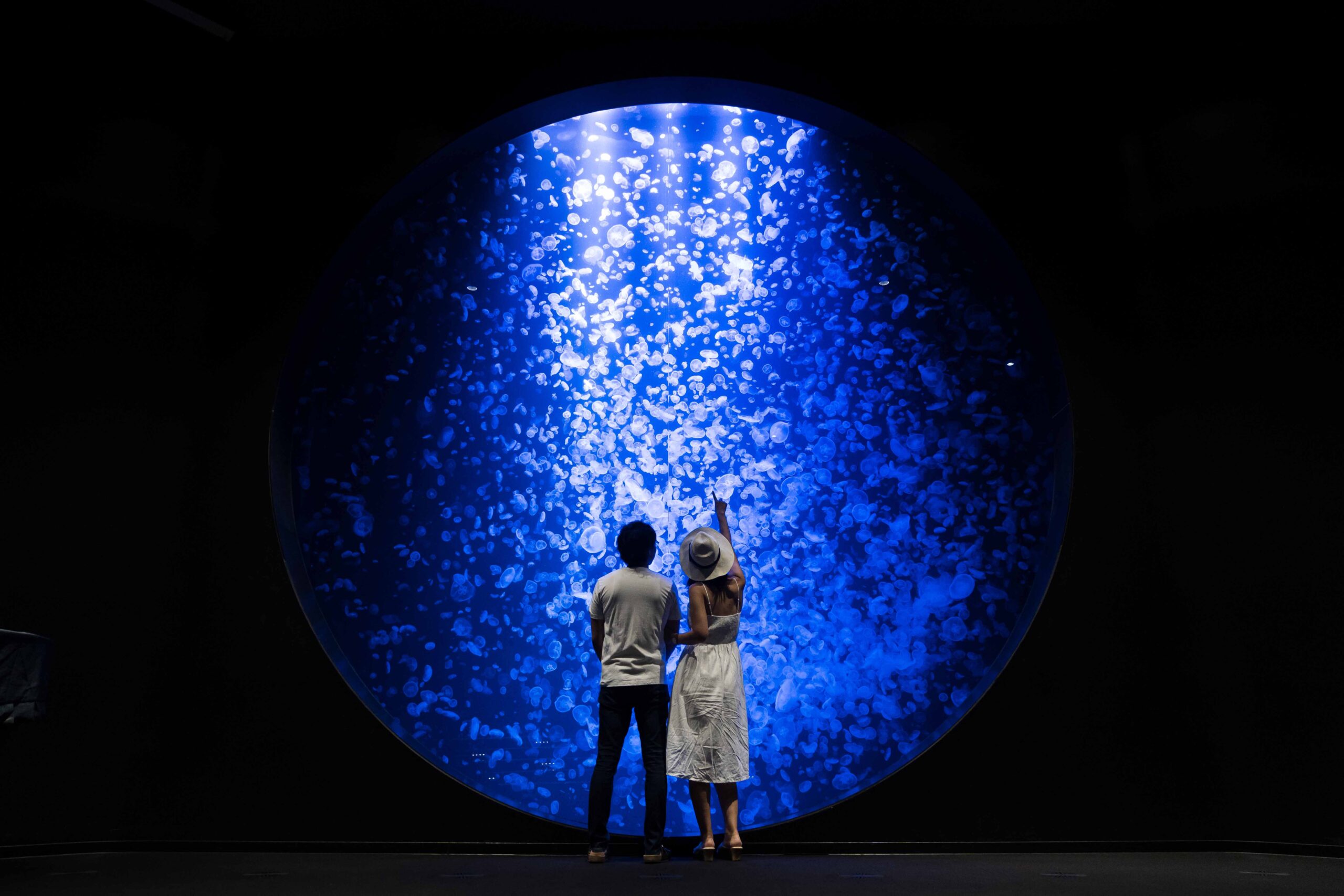
Thursday – Sakuma Cherry Farm – Cherry Picking
The Kushibiki district of Tsuruoka City enjoys an ideal fruit-growing climate, with wide day–night temperature swings, hot summers, and well-drained soils—conditions that give it the greatest diversity of fruit tree varieties in Yamagata Prefecture. Known nationwide as Japan’s “Fruit Kingdom,” Yamagata produces roughly 70 percent of the country’s cherries, making them the prefecture’s signature crop. Thanks to Yamagata’s crisp mountain air, large day-night temperature swings, and mineral-rich, well-drained soils, local growers achieve an exquisite balance of sweetness and acidity in each jewel-like fruit. Flagship varieties such as Sato Nishiki—often called the “Queen of Cherries”—and the premium Beni Shūhō are painstakingly hand-picked at peak ripeness, ensuring exceptional flavor and texture. Cherry ripes in June, so treat yourself to cherries raised with the bounty of this rich natural environment and the devoted care of local farmers. In the orchards you can enjoy cherry-picking of prized varieties such as Sato Nishiki and Beni Shūhō.

Friday – Koike Yukata Dressing + Matcha Tea & Sweets
Step into Japan’s summer tradition with our Yukata Dressing Experience—an ideal cultural encounter for international visitors. Friendly kimono specialists will guide you through each step, from selecting your favorite pattern to arranging the obi sash and styling simple accessories. In about 30 minutes you’ll be comfortably dressed in a lightweight cotton yukata, perfect for the season. Afterward, feel free to stroll through the surrounding townscape, visit nearby shrines, or pose for commemorative photos against classic Japanese backdrops. We will also enjoy Matcha tea and sweets.
